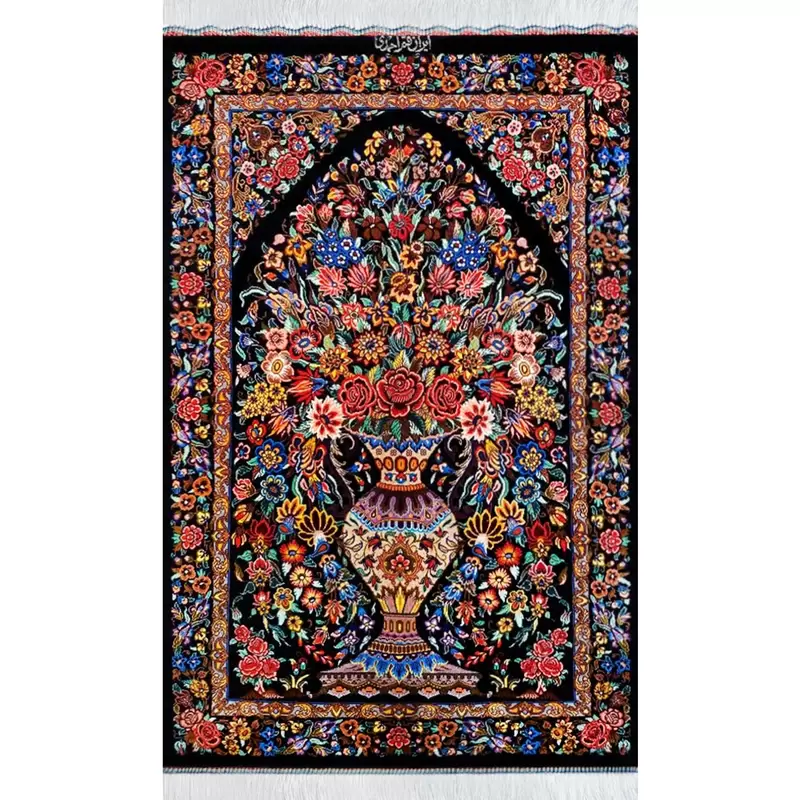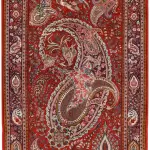Vase design and its types in carpets
In the vase design, which is one of the most beautiful and original designs of Iranian carpets, the main role is vases in various sizes that have many large or small flowers. Sometimes the mass of flowers that covers the entire carpet comes from one vase, and sometimes several small vases are seen, which are lined up one after the other and spread their flowers all over the carpet. The initiative of the "pot" design in the carpet dates back to the Safavid era of Shah Abbas. In this article, we are going to introduce the vase design and its types in Iranian carpets.
Types of vase designs in handwoven carpets
There are different types of vase designs, such as: Ghadani Khataei, Zal al-Sultan (flower and bulbul), Haj Khanmi (Joshkhan), all-round (repetitive), thousand flowers (nazem), mihrabi, two-sided, lechk and tranj, one-sided and Slimi band. This design is woven in most regions of Iran, such as Kashan, Kerman, Tabriz, Kurdistan, Fars, etc., with great variety. Vase is used in Iranian carpets as motifs and designs, and it has different names according to its use. In the following, we will introduce each type of vase design.
Slime vase design
A design consisting of vase and slim patterns in which Shah Abbasi flowers and farang flowers are used appropriately. Of course, such maps rely on images such as Guldan and Slimi. Slime's circulations appeared in the best way in carpet and tile designs almost from the middle of the Safavid era. These motifs, which are inspired by plants, are used in Iranian art with different species. The use of slimis in carpets is of particular importance and is divided into subgroups according to the taste and skill of the artist and the changes and interferences that are done in combining it with other roles, the Slimi vase is one of these types.
Haj Khanomi's vase design
This design consists of a large vase that is twice the size of the vases around it. The flowers in the vase are formed from small arrays, which are placed together to create triangular geometric shapes for the middle and bottom of the vase, and the rest of the vases around these shapes look like pine trees, and sometimes two small birds sit on the flowers around the vase. These maps have interconnected elastics. Such maps are woven in the cities of Nain and Kashan. Some consider Nazem Fars' design as a kind of Haj Khanomi design. Apparently, the term Haj Khanum Jahanara (Bibi) is meant to honor the efforts that this lady has made in reviving the Qashqai carpet weaving art of Shiraz.
Wrong flower pot design
Khatai designs are mainly based on bushes and flower branches, especially the branches of Shah Abbasi flowers, and the main motifs are tree branches, bushes, flowers and buds. Broken lines are usually absent in the fault design, and the curved lines have rhythmic twists and turns that link the flowers together. Khatai vase is a design in which the vase and Khatai motifs form the basis of the map. These types of maps are designed with different compositions, such as mihrabi, general and lakhdar. These maps are woven in Kashan, Kerman and Tehran.

Two-sided vase design
Usually, in this design, a tranji filled with flowers or a motif that is usually a round flower is seen as the central motif in the middle of the carpet, and two vases with bouquets are seen at its two ends. The rest of the map is filled with all kinds of flowers and sometimes with erratic and slimy walks. Sometimes small fringes are drawn around the pots. Such designs are woven in Qom, Kerman and Khorasan, each of which has its own line and color characteristic of its region. A type of carpet is also woven among the Qashqai tribes of Persia, which is called "Do Sar Nazem". And the basis of the design is the two vases on both sides of the main field, in the middle of which the flowers of the vases have created an orderly arrangement.
Universal flower pot design (repetitive flower pot)
This type of map is roughly divided into two categories: the first category is the designs that dominate and dominate the background of the carpet with vases that cover the entire text. The role of the vase is repeated with a brief change and sometimes exactly in a wider margin. The second category are designs in which only one big flowerpot is placed on a vertical branch and many flowers are placed on it like an umbrella, a canopy of the flowerpot. Around the vase, the branches that originated from the vertical branch slide on the surface of the map and different types of flowers give a special life to the map and carpet.
Vase design of Zal al-Sultan (flowers and nightingales)
"Zal al-Sultan" design is a design consisting of a vase full of flowers with two birds placed on both sides of it. Usually, this design is repeated throughout the carpet. This design is woven with various arrangements in different regions of Iran, including Abadeh, Bakhtiari, Qom, Nain, Varamin, Shahrbabak and Tabriz.
The design of a flower pot with bergamot and bergamot
Lach and tanraj design is one of the original designs that has been very popular since the Timurid period in carpets and other arts, including book cover decoration. The remaining examples of this design are seen in the most excellent form in the carpets of the Safavid era, and one of its exquisite examples can be called the "Sheikh Safi" carpet. In the design of the carpet map, this design is combined with different patterns and has a lot of variety. One of these types is the combination of lach and bergamot with a vase pattern. In the "pot" type, in addition to the usual motifs used in the vase design, pictures of bergamot and bergamot are also used, and the bergamot, bergamot head, and bergamot are full of flowers, and here and there you can see nightingales on the flower rings. This design can be seen in both urban and rural areas.
Altar vase design
In this design, it is based on the role of the altar, and even in most cases this design is called as potted altar, but in mentioning the types of vases, potted altar is also one of the important types. The first applications of the mihrabi design in carpets go back to the Timurid era, but the lasting examples and its widespread use go back to the Safavid era. One of the most famous and widely used types of these designs is its vase, which is found all over Iran with many and beautiful decorations. In the background of this design, there is usually a vase full of flowers, whose branches sometimes fill the entire text of the carpet up to the bottom of the altar. The vase is usually located in the middle of the lower part of the altar, and sometimes a candle is hanging above the altar. In some compositions of this type, the altar and the vase together with the column and the candlestick are depicted, that the candlestick has a symbolic relationship with the entire mosque building. This design is implemented in various ways, which is based on five patterns: altar, vase, column, lamp, and tree. Sometimes the pillars are placed on the sides of the ground, and sometimes they are located on one-third of the side of the carpet, and the altar is placed on the pillars. This design is very common in the cities of Kashan, Isfahan, Qom, etc.
Vase design of thousand flowers (Nazem)
This design is a type of "Haj Khanumi" design that is woven by Persian nomads. The main framework of this design is a porch or an entrance or a doorway, with two "cypress" trees on both sides of it, opening into a garden. Some carpet experts consider it to be an Indian weave, and another group considers it to be Indian and Iranian. Professor Pope and professor Sirus Perham consider it Persian texture and with distinguishable investigations such as the technical style of weaving, the style of design and the style and coloring that they have done on Nazem carpets in their research, they have come to the conclusion that the origin of Nazem's design is from the design of Yazd or Goldani pattern or silk fabrics of that country were in the 11th century of Hijri and they argue that due to the proximity of Yazd and Persia, it was easier and more acceptable for this pattern to find its way to Persian weavers from Yazd than other places in Iran, and they continue that this pattern is nothing but a vase. which does not contain a few flower branches.
In fact, the factor that creates the role of Nazem Kashkouli is the special way of designing a potted tree with a thousand flowers, which relies on supports, centers of gravity, specific branching centers and specific and measured lines that determine the path and direction of the expansion of branches and flowers. The other part of this role is the semi-cypresses and logs or their carved vases, curtains, vases and vases, and arched lath at the bottom of the design, decorative words that have been gradually added to the maps in the various stages of development and evolution of this role in various fields of Iranian art. Special periods are woven with various shapes, and in them, the shape of the vases and how to place the branches, cedars, as well as the use of flowers and bushes are different.
One sided vase design
The background of this map consists of a vase that is placed at the beginning of the map. The vase contains colorful flowers and the background of the map is drawn from flower bushes or swirls on which different flowers are mounted. Flower bushes and rotations are different in each region of Iran. This type of map is used in Qom, Kerman and Khorasan.
Final word
As we have seen, the pot design is one of the most common and also the most beautiful designs in Iranian carpets, which are produced in different parts of the country with features unique to their culture and taste. A carpet with a vase design is full of flowers, bushes, leaves, birds and beautiful animals, and it can be the best association of pristine nature in today's decoration space.
You can inquire about Buying Handwoven Carpets , Buying Handwoven Kilim and Mats , and Buying Handwoven Pictorial Rug Tableaus online from the Hoveida Carpet Store and register all your orders and Wherever you are in the world, deliver it to the desired address in less than 4 working days.
If you are interested in reading other articles in the field of Handwoven carpets or Handwoven Pictorial Rug Tableaus , please refer to Hoveida Carpet Commercial .
Leave a comment
Your email address will not be published. Required fields are marked *












